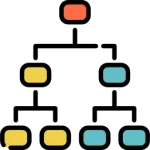Insertion in a Binary Tree (Level Order) in Java
Insertion in Binary Tree
Insertion in Binary Tree is being discussed in this article. A binary tree can be defined as a finite set of elements, which can either be empty or have at most two children. Given a tree and a key, add a node in the first available node in the tree. After adding the node, print the level order traversal.

Binary Tree
- A Binary Tree is a data structure with maximum of two children for each parent.
- Level Order Traversal is an example Of Breadth First Search algorithm.
- Level order is a traversal in which each node is visited in the level before we move to a lower level.
- Queues are used to find the level order traversal.

Algorithm
- Iterate level order traversal of the given tree using queue.
- If we find a node whose left child is empty, we make new key as left child of the node.
- Else if we find a node whose right child is empty, we make the new key as right child.
- Keep traversing the tree until we find a node whose wither left or right child is empty.
Run
import java.util.*;
class Node
{
int value;
Node left, right;
Node (int value)
{
this.value = value;
left = right = null;
}
}
class Main
{
static Node root;
//static Node temp=root;
public static void inorder (Node ptr)
{
if (ptr == null)
return;
inorder (ptr.left);
System.out.print (ptr.value + " ");
inorder (ptr.right);
}
public static void insert (Node ptr, int item)
{
if (ptr == null)
{
root = new Node (item);
return;
}
Queue < Node > que = new LinkedList < Node > ();
que.add (ptr);
while (!que.isEmpty ())
{
ptr = que.peek ();
que.remove ();
if (ptr.left == null)
{
ptr.left = new Node (item);
break;
}
else
que.add (ptr.left);
if (ptr.right == null)
{
ptr.right = new Node (item);
break;
}
else
que.add (ptr.right);
}
}
public static void main (String[]args)
{
Node root = new Node (10);
root.left = new Node (20);
root.left.left = new Node (30);
root.right = new Node (40);
root.right.left = new Node (50);
root.right.right = new Node (60);
System.out.println ("Inorder Traversal before Insertion: ");
inorder (root);
int item = 7;
insert (root, item);
System.out.println ("\nInorder Traversal after insertion");
inorder (root);
}
}
Output:
Inorder Traversal before Insertion: 30 20 10 50 40 60 Inorder Traversal after insertion 30 20 70 10 50 40 60
Prime Course Trailer
Related Banners
Get PrepInsta Prime & get Access to all 200+ courses offered by PrepInsta in One Subscription
Get over 200+ course One Subscription
Courses like AI/ML, Cloud Computing, Ethical Hacking, C, C++, Java, Python, DSA (All Languages), Competitive Coding (All Languages), TCS, Infosys, Wipro, Amazon, DBMS, SQL and others
Introduction to Trees
Binary Trees
- Binary Tree in Data Structures (Introduction)
- Tree Traversals: Inorder Postorder Preorder : C | C++ | Java
- Inorder Postorder PreOrder Traversals Examples
- Tree Traversal without Recursion
Binary Search Trees
Traversals
- Traversal in Trees
- Tree Traversals: Breadth-First Search (BFS) : C | C++ | Java
- Tree Traversals: Depth First Search (DFS) : C | C++ | Java
- Construct a Binary Tree from Postorder and Inorder
B – Trees
AVL Trees
- AVL Trees
Complete Programs for Trees
- Depth First Traversals – C | C++ | Java
- Level Order Traversal – C | C++ | Java
- Construct Tree from given Inorder and Preorder traversals – C | C++ | Java
- Construct Tree from given Postorder and Inorder traversals – C | C++ | Java
- Construct Tree from given Postorder and Preorder traversal – C | C++ | Java
- Find size of the Binary tree – C | C++ | Java
- Find the height of binary tree – C | C++ | Java
- Find maximum in binary tree – C | C++ | Java
- Check whether two tree are identical- C| C++| Java
- Spiral Order traversal of Tree- C | C++| Java
- Level Order Traversal LIne by Line – C | C++| Java
- Hand shaking lemma and some Impotant Tree Properties.
- Check If binary tree if Foldable or not.- C| C++| Java
- check whether tree is Symmetric C| C++| Java.
- Check for Children-Sum in Binary Tree- C|C++| Java
- Sum of all nodes in Binary Tree- C | C++ | Java
- Lowest Common Ancestor in Binary Tree. C | C++ | Java
Introduction to Trees
Binary Trees
- Binary Tree in Data Structures (Introduction)
- Tree Traversals: Inorder Postorder Preorder : C | C++ | Java
- Inorder Postorder PreOrder Traversals Examples
- Tree Traversal without Recursion
Binary Search Trees
Traversals
- Traversal in Trees
- Tree Traversals: Breadth-First Search (BFS) : C | C++ | Java
- Tree Traversals: Depth First Search (DFS) : C | C++ | Java
- Construct a Binary Tree from Postorder and Inorder
B – Trees
AVL Trees
- AVL Trees
Complete Programs for Trees
- Depth First Traversals – C | C++ | Java
- Level Order Traversal – C | C++ | Java
- Construct Tree from given Inorder and Preorder traversals – C | C++ | Java
- Construct Tree from given Postorder and Inorder traversals – C | C++ | Java
- Construct Tree from given Postorder and Preorder traversal – C | C++ | Java
- Find size of the Binary tree – C | C++ | Java
- Find the height of binary tree – C | C++ | Java
- Find maximum in binary tree – C | C++ | Java
- Check whether two tree are identical- C| C++| Java
- Spiral Order traversal of Tree- C | C++| Java
- Level Order Traversal Line by Line – C | C++| Java
- Hand shaking lemma and some Impotant Tree Properties.
- Check If binary tree if Foldable or not.- C| C++| Java
- check whether tree is Symmetric – C| C++| Java.
- Check for Children-Sum in Binary Tree- C|C++| Java
- Sum of all nodes in Binary Tree- C | C++ | Java
- Lowest Common Ancestor in Binary Tree- C | C++ | Java






Login/Signup to comment